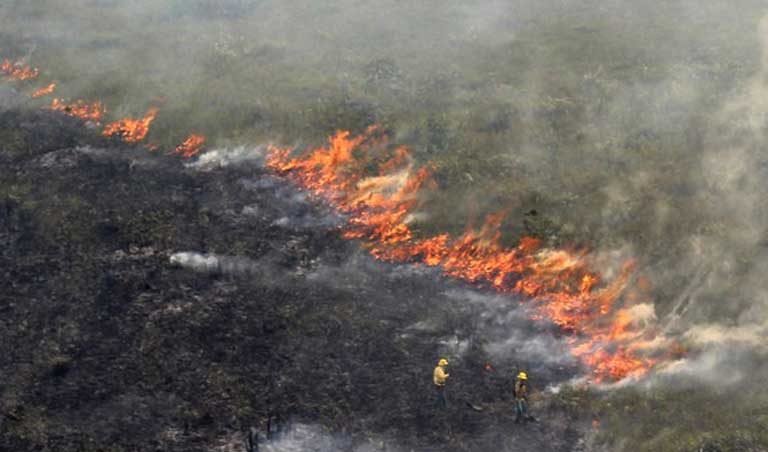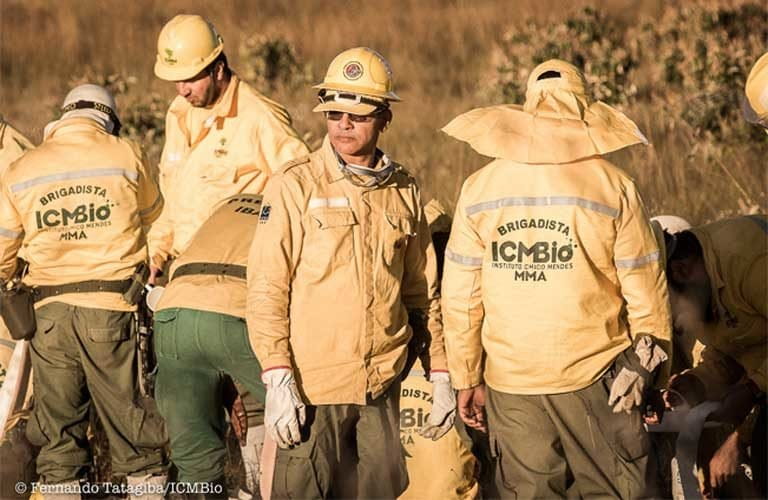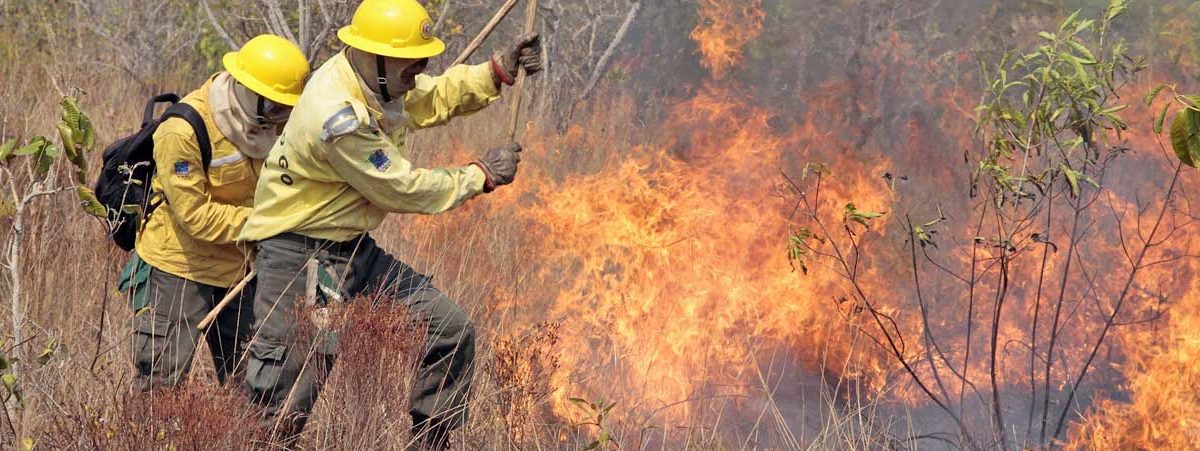- Brazil, and particularly the Amazonian state of Roraima, have seen large numbers of forest fires so far this year. From January through May, Brazil recorded 17,913 blazes nationwide, with 11,804 occurring in the nine Amazonian states. Only 2016 saw more harm in the Brazilian Amazon, when 13,663 wildfires burned over the same period.
- From January to May, Roraima registered 4,600 fires, the most numerous of any state for that period (Roraima saw just 1,970 fires during all of last year). The previous annual record for a Brazilian state was set by Mato Grosso, which suffered 4,927 forest fires in all of 2016.
- The uptick in fires is being blamed on a number of factors, including worsening Amazon drought brought by climate change, land theft and illegal deforestation (fire is typically used as a tool to clear rainforest in preparation for use by cattle ranchers and large-scale agribusiness).
- Another contributing factor: federal deforestation and firefighting policies. Since March, the Bolsonaro government has cut $7.3 million slated for fire prevention and environmental inspections to Ibama and ICMBio, Brazil’s two federal environmental agencies.

The dry season in the Brazilian Amazon state of Roraima has been more incendiary than usual this year, due to a combination of interrelated threats. Land theft, illegal deforestation, climate change and a record number of wildfires are combining to seriously damage the region’s forests. These impacts are being worsened by Brazil’s financial crisis which has drained state coffers, and by federal environmental budget reductions made by the Jair Bolsonaro government.
From January to April, wildfire spread easier and farther throughout Northern Brazil, according to the Queimadas Program, managed by Brazil’s National Institute for Space Research (INPE). Statistics through May show that the country saw an overall increase in wildfires, with 17,913 registered blazes. Most of these occurred in the Amazon, with 11,804 cases registered across Brazil’s nine Amazonian states. Only 2016 saw more harm, when 13,663 wildfires burned in the basin, home to the biggest remaining rainforest on the planet.
Over the same period this year, Roraima registered 4,600 registered fires, which made it the most affected in the country (Roraima saw just 1,970 fires during all of last year). 2019’s statistics become even more impressive when one considers that the previous record for a Brazilian state was set by Mato Grosso, which suffered 4,927 forest fires in all of 2016. Mato Grosso is located on the expanding edge of the so-called Amazon Deforestation Arc. The state also contains part of another endangered biome, the Cerrado savanna, where agribusiness plantations are rapidly replacing native vegetation, which helps explain its high number of wildfires.
To fully understand the factors behind this year’s increase in fires, it’s necessary to look at historic causes: most dry season wildfires in Brazil are not natural, but are lit by farmers and industrial agribusiness to renew land for planting (with those fires then often raging out of control and burning forests). Or they are intentionally and illegally set by land thieves, speculators who burn off rainforest in order to make land more valuable for resale to cattle ranchers and crop growers.
“Here [in the Amazon], fires are always linked to deforestation,” explains Joaquim Parimé, the regional superintendent of Ibama in Roraima, Brazil’s federal environmental protection agency.

Parks on fire
Wildfires in Roraima over recent months, and the lack of federal resources available to deal with them, are exemplified by recent events in Viruá National Park.
This federal conservation unit, created in 1998, covers 241,948 hectares (934 square miles), and protects an unusual Amazon rainforest ecosystem known as a Neotropical white-sand forest, which occurs regionally as “habitat islands” beside rivers. Viruá conserves a unique Amazonian marshland that protects the Branco and Baruana rivers, along with extraordinary biodiversity. It is home to jaguars and more than 500 species of birds, many of them endangered.
Unfortunately for the park, it is also located in Caracaraí, the municipality most impacted by forest fires in Brazil during early 2019; the interior of the park too suffered a number of blazes between January and April.
“There are indications that the recent fires in Viruá National Park originated [on private properties] outside the unit,” explains Christian Berlinck, Superintendent of Firefighting and Prevention with the Chico Mendes Institute for Biodiversity Conservation (ICMBio), the federal agency that manages Brazil’s federal parks and other conservation units, such as wildlife refuges.
In March, Caracaraí — a municipality larger than Switzerland — saw 800 fires. Farther north in February, in Amajari (a municipality within 93 miles of Boa Vista the state capital) an emergency was declared, with new fires registered daily. Contributing to the emergency: Amajari faces historical problems of land tenure and land grabbing, including allegations that involve local politicians.
“Much of the land in the Brazilian Amazon is in the public domain,” explains Philip Fearnside at the Amazon National Research Institute. Typically that public “land enters the private domain by first being illegally invaded either by squatters or by grileiros (land grabbers), and eventually the government recognizes the claims and grants title.”

In Roraima, a clear link has been established by authorities between forest fires, land grabbing and the illegal timber extraction market, focused on species such as the coveted maçaranduba tree.
“Land grabbing in the Amazon has different [stages]: first, the land grabbers tear down the timber species to make a profit. Then, what’s left of the original vegetation is deforested, replaced by cattle pasture, which [then] serves as a proof that the land is ‘productive,’ making it easier for land grabbers to obtain title,” explains an Imazon document; Imazon is a Brazilian research institute that monitors Amazon deforestation.
The grileiros often also set fire to a forest in order to intimidate and expel anyone who may already be living there, including indigenous and traditional peoples, who as squatters may be attempting to establish legitimate settlements as part of Brazil’s longstanding land reform program. As a result, the grileiros are in near constant conflict with these communities across Brazil, but especially in the Amazon, where rural settlements are often far from the help of law enforcement.

“In 2019 we received reports of land grabbing and data packages [generated via satellite monitoring] indicating [newly] deforested areas. We have worked practically by ourselves this year,” says the Ibama superintendent for Roraima. The agency only managed to pay for this year’s operations because it had money earmarked for that purpose allotted last year; Ibama says it had nearly no municipal or state support for preventing deforestation and wildfires in Roraima so far this year.
Recent Imazon reports show that deforestation continues to worsen in Roraima: hotspots of illegal timber extraction, such as Caracaraí, Mucajaí and Rorainópolis have lost 75 square kilometers (18,532 acres) of forest combined from January to April 2019.
The most recent Brazilian Amazon deforestation statistics are also worrying. In May alone, the region lost 285 square miles — equivalent to two soccer fields per minute. This represents an increase of 34 percent in comparison to the same period in 2018. Some environmentalists and researchers say this is likely the result of Jair Bolsonaro’s forest policies, though others caution that a one month tally isn’t long enough to document an annual upturn in deforestation, with more monthly data needed before a trend can be identified.

Climate change worsens wildfires
The increase in forest fires isn’t only of concern to Roraima state. Amazon fires release vast amounts of carbon to the atmosphere, so their growing number is escalating global warming, while putting Brazil’s carbon reduction commitments pledged in the 2015 Paris Climate Agreement at risk.
Recent reports by Brazil’s National Institute for Space Research (INPE) confirm that, due to the rising number of wildfires, current deforestation policies won’t likely be sufficient to curb greenhouse gas emissions in Brazil to meet the nation’s Paris Agreement carbon targets.
Importantly, other INPE studies indicate that climate change is altering the Amazon’s historical forest fire cycle. Climate shifts are extending droughts. During those longer droughts, Amazonian trees become weaker and dehydrated, resulting in more tree death, which means more fuel for the easy spread of fires.
Federal environmental agencies say that a trend toward an El Niño early in 2019 helped reduce rain amounts, extending regional drought not only in Roraima, but also in Amapá state and in Brazil’s Northeast.
In 2015, the El Niño Southern Oscillation (ENSO), the Atlantic Multidecadal Oscillation (AMO) and the Pacific Decadal Oscillation (PDO) combined, producing a severe Amazon drought. Such cycles alter global weather patterns, changing ocean temperatures and the strength of trade winds, which result in lower rainfall over the Amazon basin. The possibility of a major El Niño has faded for the rest of 2019.
Still, climate change is intensifying these once atypical events, and making them more frequent. But the Bolsonaro government seems little interested in knowing about, or being prepared for, deepening drought.
In March, the administration cut 95 percent of the annual budget dedicated to its National Policy on Climate Change. Originally, the ministry overseeing the program had been funded with 11.8 million Reals (US$2.9 million) for climate change actions this year, which has since been reduced to 500,000 Reals (about US$125,875).
“Climate change is likely to extend drought in [several] biomes, [including] the Cerrado and the Amazon, which is a major concern,” said an ICMBio expert on fire prevention, who spoke anonymously in fear of government repercussions.

Less money for equipment, prevention and inspection
Since March, Ibama and ICMBio, Brazil’s two federal environmental agencies, have lost more than 30 million Reals (US$7.3 million) slated for fire prevention and environmental inspections. The sharp decline in these federal resources is especially dire in light of the current deep financial crisis in Brazilian states.
“Roraima [is experiencing a] financial calamity,” said Ibama’s regional superintendent. “There are few state [fire] inspectors and, when needed, we seek support from neighboring states during this most critical [dry season] period. [In 2019] we are working more than in previous years, mainly due to the increase in heat/fire sources [along with] other problems related to deforestation in the state.”
Banner image: Federal firefighters try to control a Xingu basin blaze. Image by Vinicius Mendonça / Ibama
FEEDBACK: Use this form to send a message to the author of this post. If you want to post a public comment, you can do that at the bottom of the page.
